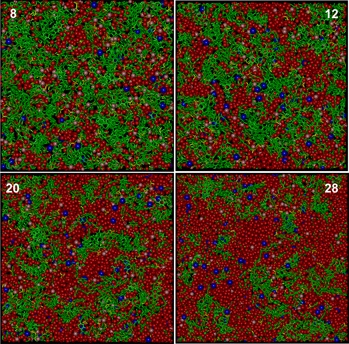Published online by Cambridge University Press: 07 June 2012

We have used molecular dynamics simulations to examine membrane morphology and the transport of water, methanol, and hydronium in phenylated sulfonated poly(ether ether ketone ketone) (Ph-SPEEKK) and Nafion membranes at 360 K for a range of hydration levels. In Ph-SPEEKK, the average pore diameter is smaller, the sulfonate groups are more closely packed, the hydronium ions are more strongly bound to sulfonate groups, and the diffusion of water and hydronium is slower relative to the corresponding properties in Nafion at comparable hydration levels. The aromatic carbon backbone of Ph-SPEEKK is more rigid and less hydrophobic than the fluorocarbon backbone of Nafion. Water network percolation in Ph-SPEEKK occurs at a hydration level (λ) of ∼8 H2O/SO3−. At λ = 20, water, methanol, and hydronium diffusion coefficients were 1.4 × 10−5, 0.6 × 10−5, and 0.2 × 10−5 cm2/s, respectively. For λ > 20, wide pores develop leading to an increase in methanol crossover and ion transport.